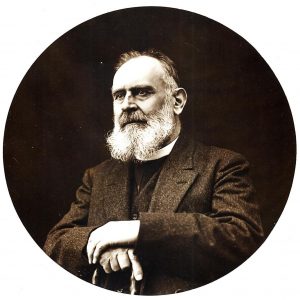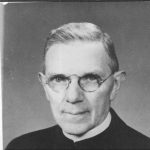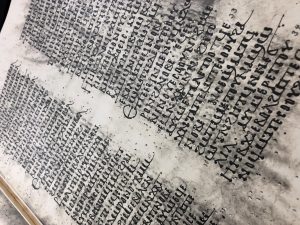 Henry Hyvernat (1858-1941), the youngest member of the original faculty of The Catholic University of America, spent fifty-two years in distinguished service to The Catholic University of America. He was Professor of Oriental Languages and Biblical Archaeology (1889-1895/96) as part of the Faculty of Theology, and then Professor of Semitic Languages and Biblical Archaeology (1895/96-1910/1911) in the new School of Philosophy’s Department of Letters. He served as Professor of Semitic Languages and Literatures (1911/12-1940/41) in what is today the Department of Semitic and Egyptian Languages and Literatures (School of Arts and Sciences). He is best known as a scholar of Coptic, the language of Christian Egypt.
Henry Hyvernat (1858-1941), the youngest member of the original faculty of The Catholic University of America, spent fifty-two years in distinguished service to The Catholic University of America. He was Professor of Oriental Languages and Biblical Archaeology (1889-1895/96) as part of the Faculty of Theology, and then Professor of Semitic Languages and Biblical Archaeology (1895/96-1910/1911) in the new School of Philosophy’s Department of Letters. He served as Professor of Semitic Languages and Literatures (1911/12-1940/41) in what is today the Department of Semitic and Egyptian Languages and Literatures (School of Arts and Sciences). He is best known as a scholar of Coptic, the language of Christian Egypt.
The Hyvernat Papers are housed in Special Collections (#56 University Archives). They cover a span of some sixty-five years, from 1876 through and beyond his death in 1941. The growth and development of Coptic studies as a modern academic discipline can be tracked in the Hyvernat Papers. Series 1. General Correspondence [17 manuscript boxes = 7.33 linear ft.] is a “Who’s Who” of several generations of Coptologists and Orientalists. Series 2. Professional Correspondence. Morgan Collection [6 manuscript boxes = 2.5 linear ft.; currently on loan to the Semitics/ICOR library] contains much information about one of the major twentieth-century discoveries of ancient Christian documents in Egypt, the library associated with the Coptic Monastery of St. Michael near the modern town of Hamuli in the Egyptian Fayyum. These Papers relate to the purchase of the manuscripts by the American financier J. Pierpont Morgan (1837-1913), Hyvernat’s commission to work on them, and Vatican Library restoration work on the manuscripts.

The Research Papers of two other CUA Coptic scholars are housed in the Semitics/ICOR Library. (1) The Papers of Fr. Theodore Christian Petersen, C.S.P. (1883-1966) [3 filing cases = 24 linear ft.], Hyvernat’s student, colleague, and eventual successor in the Semitics department and the Institute of Christian Oriental Research (ICOR) after Hyvernat’s death. The Papers contain Petersen’s collaborative work with Hyvernat on the Coptic manuscripts of the Morgan Library & Museum and Petersen’s own studies of Coptic manuscript ornament and Coptic bindings. Included are the various manuscript drafts of Petersen’s unpublished study of Coptic bindings in the Morgan Collection. An edition of Petersen’s study of the Morgan Coptic bindings is expected this year. The Petersen Papers also include a 1935 manuscript copy of Hyvernat’s unpublished “Catalogue of the Coptic Manuscripts in the Pierpont Morgan Library” (452 leaves). (2)The Papers of Prof. Paulinus Bellet, O.S.B. (1913-1987) [2 filing cases = 15 linear ft.]. His own research was centered on the Coptic Bible and the Coptic manuscript tradition. Bellet served as Coptic editor for the Madrid Biblia Polyglotta. His Papers also include facsimile copies (microfilm and photographs) and transcriptions of Coptic manuscripts, and card file indexes.
Since March 2018 the Semitics/ICOR Library has partnered with the University Libraries Resource Management (Preservation) and then with the University Libraries Electronic Resources and Services to begin digitizing some of the Coptic research materials here. In April 2019 Katherine DeFonzo, GLP, Semitics/ICOR Library, took on primary responsibility for digitizing the ICOR collections.
Three Coptic resources are now available in Islandora:
(1) Bybliothecae Pierpont Morgan codices coptici photographice expressi… 56 vols. in 63 and 1 index vol. (8,582 images) 
This is CUA’s copy of the 1922 folio facsimile edition of the Morgan Coptic codices (Hamuli Collection) prepared by Hyvernat. Only twelve sets were printed. Two of the twelve sets were reserved for the Morgan Library (now the Morgan Museum and Library) and for The Catholic University of America. The remaining ten sets were distributed around the world to the Vatican Library, the Egyptian government, and to major American and European universities and libraries. Forty-seven of the fifty-six volumes of the edition include the Hamuli codices at the Morgan Museum and Library; four volumes include the Hamuli codices at the Cairo Coptic Museum; five other volumes include Morgan Coptic manuscripts not from Hamuli. Two of the twelve sets, those at CUA and at the Morgan Museum, include facsimiles of additional related leaves not present in the other sets.
The Bybliothecae Pierpont Morgan codices coptici photographice expressi… is housed in the Semitics/ICOR Library. Shelved nearby is Hyvernat’s working set of bound photostats (reduced size) of the manuscripts. Some of the photostat images appear to show evidence of binding details no longer fully visible in the facsimile edition.
(2) 1911 Galleys of a dealer’s catalog of the Hamuli Coptic manuscripts written by the French Egyptologist Émile Chassinat (1868-1948) with the assistance of Hyvernat. The dealer’s catalog was never published because the financier J. Pierpont Morgan (1867-1943) purchased most of these manuscripts in 1911. The two sets of galley proofs were extensively annotated by Hyvernat. They provide access to the manuscripts before the purchase, and before restoration work was done on the manuscripts. (286 images).
(3) Hyvernat’s unpublished catalogs of Coptic manuscripts in European libraries: Hyvernat. Coptic MSS Berlin [1889] Berlin and London (95 images) , Hyvernat. Coptic MSS Vatican Library (167 images), Hyvernat. Coptic MSS Clarendon Press [1886-1887] (261 images), Hyvernat. Crawford and Curzon Collections [n.d.] (167 images), Hyvernat. Coptic MSS Bibliothèque nationale. Paris [ca. 1886; later entries 1931] (123 images), Hyvernat. Coptic MSS Bodleian Library [n.d.] (173 images).
Manuscript collections are not static. The physical condition, location, and local identification of individual items and collections may change over time. Hyvernat’s catalogs provide valuable information about these collections as they were when he visited them–a snapshot in time. In 2017 Mark Sheridan OSB, CUA alumnus and former rector and dean of faculty, Pontifical Athenaeum of St. Anselm, Rome presented a public lecture on the value of Hyvernat’s 1886/1887 Clarendon Press catalog in tracking these manuscripts in the Bodleian Library (Oxford): “Hidden in Plain Sight: On the Trail of the Clarendon Press Manuscripts from Mullen Library (CUA) to the Bodleian (Oxford)” .
